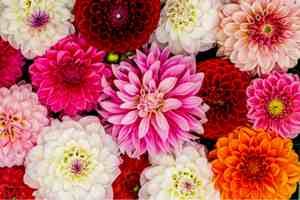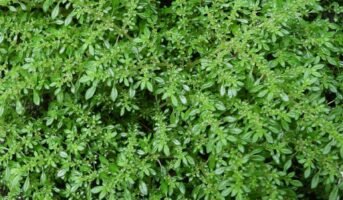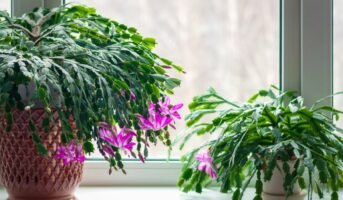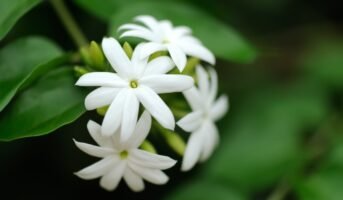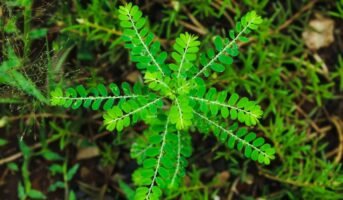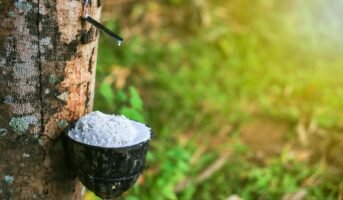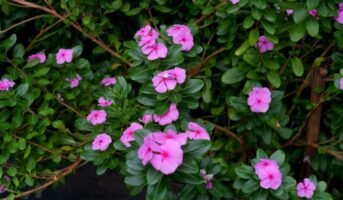A plant that survives for more than two years is known as a perennial plant or just perennial for short. It is common practice to use the phrase to distinguish a plant from annuals and biennials, which have a shorter lifespan. The word is also commonly used to differentiate plants with little or no woody development (secondary growth in girth) from trees and shrubs, both of which are officially considered to be perennials due to their long life spans. Scadoxus multiflorus also belongs to the Perennial type of plant. Learn more here. You can also grow Caladium bicolor as a perennial plant in your garden. Learn more about it

Source: Wikipedia
Know about the Purple Fleabane
Herbaceous perennials are a type of perennial plant that grows and blooms during spring and summer, then dies back during the fall and winter months, and then returns in the spring from their rootstock or another type of overwintering structure. These perennials tend to be smaller flowering plants.
However, a gardener may decide to treat a plant that is a perennial in its natural habitat or in a garden with a climate that is not as harsh as an annual and plant it out each year, either from seed, cuttings or from divisions. This decision will depend on the severity of the climate in the area.
Tomato vines, for instance, may live for several years in their natural environment in the tropical and subtropical areas of the world. However, in temperate countries, they are produced as annuals since the above-ground biomass of the plant does not last the winter.
There is also a type of evergreen perennials that do not have woody stems, such as Bergenia, which maintains a cloak of leaves throughout the year. These plants are known as “herbaceous evergreens.” Subshrubs are a category of plants that fall between shrubs and herbs. These plants, like penstemon, have a woody structure that persists into the winter.
Perennial plants: Types
- Begonias, bananas, and other woody plants like pines and hollies are some examples of perennials that retain their foliage year after year.
- Some examples of deciduous perennials are goldenrod, mint, and woody plants like maples and lilacs. Goldenrod is also an example of a deciduous perennial.
- The agave and several members of the genus Streptocarpus are both examples of monocarpic perennials.
- Vine-like shrubs and trees, such as maple, pine, and apple trees, are all examples of woody perennials. Woody vines also fall under this category.
- Alfalfa, Thinopyrum intermedium, and red clover are some examples of herbaceous perennials that are utilised in agricultural settings.
Perennial plants: Cultivation
Herbaceous food crops such as asparagus, rhubarb, and strawberries are examples of perennials that are cultivated, as are subtropical plants that are not hardy in colder areas, such as tomatoes, eggplant, and coleus. Other types of perennials include woody plants such as fruit trees that are grown for the edible fruits they produce, shrubs and trees that are grown as landscaping ornamentals and woody plants such as fruit trees. Plants that are grown for their ability to blossom and for other decorative purposes are classified as perennials. Examples of perennials include bulbs (such as tulips, narcissus, and gladiolus), lawn grass, and various groundcovers.
The process of separating each variety of plant requires a unique approach; for instance, plants with fibrous root systems, such as daylilies, Siberian iris, or grasses, can be separated by inserting two garden forks back to back and prying them apart or by cutting them with knives. However, certain plants, like bearded irises, have a root system that is composed of rhizomes. Rhizome-based root systems need to be planted with the top of the rhizome slightly above ground level, and the leaves from the next year should be visible. The purpose of dividing perennials that you already have in your garden is to enhance the overall quantity of a specific type of plant.
How to grow and maintain Perennial plants
- Ensure that the soil is prepared before digging, rather than just removing the weeds and digging once.
- To see how the bare root clumps will look, arrange them on the surface.
- Using a trowel or spade, dig a hole as deep and wide as the roots of the plant. Only the roots need to be buried, leaving the stems and/or shoots above ground during summer.
- You can use your hand for small clumps and your heels for larger ones when firming back the soil.
- When the soil is moist and rain is forecast, water it well. This will settle the soil and prevent desiccation.
See also: What is Okra and what are its benefits?
How to care for Perennial plants?
Perennial plants have to be taken care according to change of season so that they grow well. Start with cutting weeds and testing soil in March. In April, remove the winter protection and divide plants. Make cages. In May, plant the perennials, put fertilizers and water . From June to September take care of the plant by monitoring it for weeds, pests, divide the plants and water. In October/ November once the ground is frozen, winterise the garden.
Perennial plants: Benefits in agriculture
Even if the majority of people on the planet are nourished by the replanting of the seeds of annual grain crops (which can occur naturally or through the labour of man), perennial crops provide a number of advantages that cannot be ignored. Many perennial plants have vast root systems that can hold soil in place to prevent its loss, collect dissolved nitrogen before it can pollute ground and surface water, and out-compete weeds.
These traits allow perennial plants to resist soil erosion (reducing the need for herbicides). Owing to these possible advantages of perennials, there have been recent efforts made to boost the seed production of perennial species, which may lead to the development of novel perennial grain crops. Perennial rice and intermediate wheatgrass are two examples of new types of perennial crops that are currently being developed. According to estimations provided by the Land Institute, it will take at least 25 years before lucrative and productive perennial grain crops can be achieved.
See also: Are chia seeds worth all the rage?
Perennial plants: Location
Perennial plants dominate many natural habitats on land and in freshwater, but only a very small number of perennial plants (such as Zostera) are found in shallow marine waters. Herbaceous perennial plants are especially prevalent in environments that are too fire-prone for trees and shrubs. For example, the majority of plants that grow on grasslands and steppes are perennials. Perennials are also the most common type of plant in the tundra that is too cold for tree development. Almost all of the plants that grow in a forest are perennials, and this includes trees and bushes.
In most cases, perennial plants are superior competitors over the long run, particularly in stable environments with a scarcity of resources. This happens as a result of the growth of bigger root systems, which are able to reach water and soil nutrients deeper in the soil, as well as the earlier emergence of the plant in the spring. Because of their quicker growth and reproduction rates, annual plants have a competitive advantage in habitats prone to disturbance.

Source: Wikipedia
How to use Perennial plants in home
Perennial plants in home help in cleaning the air quality inside the house. As these last long, you don’t need to replace perennial plants in the home for a long time. Spider plants, Lily, Gerbera Daisy, Ferns, Aloe Vera and Golden Pathos are some of the plants you can use at your home to beautify it as well as clean the air.
FAQs
Perennial plants are what kind of plants?
A perennial plant persists from one season to the next, usually with herbaceous growth from a part that survives.
Perennials last for how many years?
The life cycle of a perennial plant lasts for more than two years.
What is the most popular perennial plant?
Hemerocallis (Daylily) is the most popular perennial plant.
Housing News Desk is the news desk of leading online real estate portal, Housing.com. Housing News Desk focuses on a variety of topics such as real estate laws, taxes, current news, property trends, home loans, rentals, décor, green homes, home improvement, etc. The main objective of the news desk, is to cover the real estate sector from the perspective of providing information that is useful to the end-user.
Facebook: https://www.facebook.com/housing.com/
Twitter: https://twitter.com/Housing
Email: [email protected]
